AAO-NANOS Neuro-Ophthalmology Clinical Collection: Derived from the AAO-NANOS Clinical Neuro-Ophthalmology collection produced on CD. The images are of selected cases from the NANOS teaching slide exchange, and the CD was produced under the direction of Larry Frohman, MD and Andrew Lee, MD.
The American Academy of Ophthalmology (AAO); The North American Neuro-Ophthalmology Association (NANOS).
NOVEL: https://novel.utah.edu/
TO
| Title | Creator | Description | ||
|---|---|---|---|---|
| 176 |
 |
Neuro-Ophthalmic Vascular Disease | Mark J. Kupersmith, MD | A 9-year-old boy had recurrent ischemic episodes that had begun 2 years prior to evaluation. A significant right hemiparesis and a significant speech, learning, and memory disorder were present. His noncontrast axial view CT scan demonstrated multiple cerebral infarcts. Cerebral angiography revealed... |
| 177 |
 |
Neuro-Ophthalmic Vascular Disease | Mark J. Kupersmith, MD | MR angiography was performed on this 33-year-old woman, who complained of the onset of a bad taste in her mouth followed by pain along the left forehead and development of the left third-order Horner's syndrome during pregnancy. Except for the Horner's syndrome, the patient was neurologically intact... |
| 178 |
 |
Neuro-Ophthalmic Vascular Disease | Jacqueline A. Leavitt, MD | Arteriovenous malformations are dysplastic vascular channels. They may result in neuro-ophthalmologic findings from direct compressive effects, secondary hemorrhage, or secondary seizure disorder. CT and/or MRI may demonstrate the lesion, but cerebral arteriography is usually required to better defi... |
| 179 |
 |
Neuro-Ophthalmic Vascular Disease | Larry P. Frohman, MD | This 23-year-old woman has had insulin-dependent diabetes mellitus since age 3. She was diagnosed with Sydenham's chorea in early childhood and had grand mal seizures from age 13 to 15. She has been hypertensive since age 18. Her vision was 20/25 OD and 20/40 OS, with dyschromatopsia OS, and a 1.8 l... |
| 180 |
 |
Neuro-Ophthalmic Vascular Disease | Anthony C. Arnold, MD | This 76-year-old woman has a 7-month history of redness and pressure sensation in both eyes that is worse in the morning. She has noted intermittent horizontal diplopia during this time. Angiography demonstrated a right dural cavernous sinus fistula, which was successfully occluded with direct injec... |
| 181 |
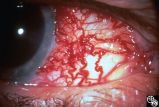 |
Neuro-Ophthalmic Vascular Disease | Anthony C. Arnold, MD | This 76-year-old woman has a 7-month history of redness and pressure sensation in both eyes that is worse in the morning. She has noted intermittent horizontal diplopia during this time. Angiography demonstrated a right dural cavernous sinus fistula, which was successfully occluded with direct injec... |
| 182 |
 |
Neuro-Ophthalmic Vascular Disease | Anthony C. Arnold, MD | This 76-year-old woman has a 7-month history of redness and pressure sensation in both eyes that is worse in the morning. She has noted intermittent horizontal diplopia during this time. Angiography demonstrated a right dural cavernous sinus fistula, which was successfully occluded with direct injec... |
| 183 |
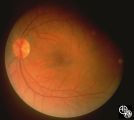 |
Neuro-Ophthalmic Vascular Disease | Larry P. Frohman, MD | This 32-year-old woman was referred with a history of 4 days of loss of vision OD. She had a history of manic depressive illness and IV drug abuse; she had been HIV tested 4 weeks before and was negative. She said she last injected cocaine 5 days before being seen, the night before she awoke with th... |
| 184 |
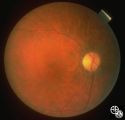 |
Neuro-Ophthalmic Vascular Disease | Larry P. Frohman, MD | This 32-year-old woman was referred with a history of 4 days of loss of vision OD. She had a history of manic depressive illness and IV drug abuse; she had been HIV tested 4 weeks before and was negative. She said she last injected cocaine 5 days before being seen, the night before she awoke with th... |
| 185 |
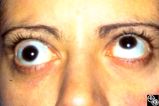 |
Neuro-Ophthalmic Vascular Disease | Larry P. Frohman, MD | This 32-year-old woman was referred with a history of 4 days of loss of vision OD. She had a history of manic depressive illness and IV drug abuse; she had been HIV tested 4 weeks before and was negative. She said she last injected cocaine 5 days before being seen, the night before she awoke with th... |
| 186 |
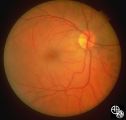 |
Neuro-Ophthalmic Vascular Disease | Larry P. Frohman, MD | This 32-year-old woman was referred with a history of 4 days of loss of vision OD. She had a history of manic depressive illness and IV drug abuse; she had been HIV tested 4 weeks before and was negative. She said she last injected cocaine 5 days before being seen, the night before she awoke with th... |
| 187 |
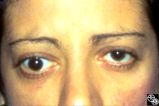 |
Neuro-Ophthalmic Vascular Disease | Larry P. Frohman, MD | This 32-year-old woman was referred with a history of 4 days of loss of vision OD. She had a history of manic depressive illness and IV drug abuse; she had been HIV tested 4 weeks before and was negative. She said she last injected cocaine 5 days before being seen, the night before she awoke with th... |
| 188 |
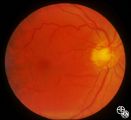 |
Neuro-Ophthalmic Vascular Disease | Robert F. Saul, MD | In image 93_29, taken during the episode, note the change in caliber of the blood vessels. |
| 189 |
 |
Neuro-Ophthalmic Vascular Disease | Robert F. Saul, MD | Image 93_30 is immediately after the attack, note the slight redness to the macula. |
| 190 |
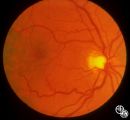 |
Neuro-Ophthalmic Vascular Disease | Robert F. Saul, MD | Image 93_28 shows the fundus before the attack. |
| 191 |
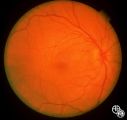 |
Neuro-Ophthalmic Vascular Disease | Larry P. Frohman, MD | This 23-year-old woman has had insulin-dependent diabetes mellitus since age 3. She was diagnosed with Sydenham's chorea in early childhood and had grand mal seizures from age 13 to 15. She has been hypertensive since age 18. Her vision was 20/25 OD and 20/40 OS, with dyschromatopsia OS, and a 1.8 l... |
| 192 |
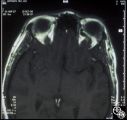 |
Neuro-Ophthalmic Vascular Disease | Larry P. Frohman, MD | This 27-year-old woman had no past ocular history and presented with 3 weeks of redness OS that has been treated by the referring doctor as allergic conjunctivitis. She was referred for evaluation when she developed binocular diplopia. Her past medical history included phlebitis and one miscarriage ... |
| 193 |
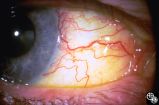 |
Neuro-Ophthalmic Vascular Disease | Anthony C. Arnold, MD | This 76-year-old woman has a 7-month history of redness and pressure sensation in both eyes that is worse in the morning. She has noted intermittent horizontal diplopia during this time. Angiography demonstrated a right dural cavernous sinus fistula, which was successfully occluded with direct injec... |
| 194 |
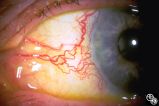 |
Neuro-Ophthalmic Vascular Disease | Anthony C. Arnold, MD | This 76-year-old woman has a 7-month history of redness and pressure sensation in both eyes that is worse in the morning. She has noted intermittent horizontal diplopia during this time. Angiography demonstrated a right dural cavernous sinus fistula, which was successfully occluded with direct injec... |
| 195 |
 |
Neuro-Ophthalmic Vascular Disease | Anthony C. Arnold, MD | This coronal CT scan shows the enlarged superior ophthalmic vein in the left orbit. This 76-year-old woman has a 7-month history of redness and pressure sensation in both eyes that is worse in the morning. She has noted intermittent horizontal diplopia during this time. Angiography demonstrated a ri... |
| 196 |
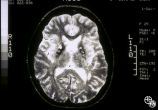 |
Neuro-Ophthalmic Vascular Disease | Larry P. Frohman, MD | This 23-year-old woman has had insulin-dependent diabetes mellitus since age 3. She was diagnosed with Sydenham's chorea in early childhood and had grand mal seizures from age 13 to 15. She has been hypertensive since age 18. Her vision was 20/25 OD and 20/40 OS, with dyschromatopsia OS, and a 1.8 l... |
| 197 |
 |
Neuro-Ophthalmic Vascular Disease | Larry P. Frohman, MD | This 23-year-old woman has had insulin-dependent diabetes mellitus since age 3. She was diagnosed with Sydenham's chorea in early childhood and had grand mal seizures from age 13 to 15. She has been hypertensive since age 18. Her vision was 20/25 OD and 20/40 OS, with dyschromatopsia OS, and a 1.8 l... |
| 198 |
 |
Neuro-Ophthalmic Vascular Disease | Mark L. Moster, MD | Neovascularization of the iris may form in response to an ischemic disease of the retina, such as diabetic retinopathy. Carotid artery occlusion may result in ocular ischemia that may induce neovascularization.This is a dramatic image of iris neovascularization. |
| 199 |
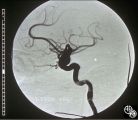 |
Neuro-Ophthalmic Vascular Disease | Mark J. Kupersmith, MD | Aneurysms of the intracranial circulation may act as mass lesions and compress the afferent of efferent visual pathway. Ophthalmic artery aneurysms may compress the optic nerve and result in an optic neuropathy (ie, visual loss, afferent pupillary defect, optic atrophy). Treatment includes endovascu... |
| 200 |
 |
Neuro-Ophthalmic Vascular Disease | Mark J. Kupersmith, MD | Aneurysms of the intracranial circulation may act as mass lesions and compress the afferent of efferent visual pathway. Ophthalmic artery aneurysms may compress the optic nerve and result in an optic neuropathy (ie, visual loss, afferent pupillary defect, optic atrophy). Treatment includes endovascu... |
